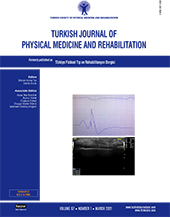Orthostatic hypotension and age-related sarcopenia
2 Department of Physical Medicine and Rehabilitation, University of Health Sciences, Şişli Hamidiye Etfal Training and Research Hospital, Istanbul, Turkey DOI : 10.5606/tftrd.2021.5461 Objectives: This study aims to determine the association of sarcopenia with orthostatic hypotension (OH) which is a significant precursor to falls and related injuries in elderly patients.
Patients and methods: A total of 91 outpatients (18 males, 73 females; mean age 79.3±4.0 years; range, 75 to 91 years) were prospectively enrolled and those who were eligible underwent comprehensive sarcopenia assessment including measurement of muscle mass, strength, physical performance, anthropometric measurements along with frailty tests. Patients classified as sarcopenic or non-sarcopenic based on these measurements underwent supine and standing blood pressure (BP) measurements. The frequency of OH was compared between the two groups.
Results: Of the 91 patients, 29 (31.9%) had sarcopenia. There was no statistical difference in measurements of functional tests which consisted of gait speed, timed up-and-go test and handgrip strength. However, timed sit-to-stand test values were higher in sarcopenic patients (18.2±7.9 vs. 15.0±5.1, p=0.04). Patients with sarcopenia developed OA and intolerance more often compared to the non-sarcopenic patients (n=15 [50.0%] vs. n=14 [23.0%], p<0.01 and n=13 [44.8%] vs. n=9 [15.3%], p<0.01, respectively). The adjusted odds ratio for sarcopenia was 7.80 (95% confidence interval 1.77-34.45), p=0.007.
Conclusion: Age-related sarcopenia increases the risk of OA in the elderly. This may in part explain the increased incidence of falls and also help identification of risky elderly patients for orthostatic BP drops.
Keywords : Blood pressure, elderly, frailty, orthostatic hypotension, sarcopenia

















